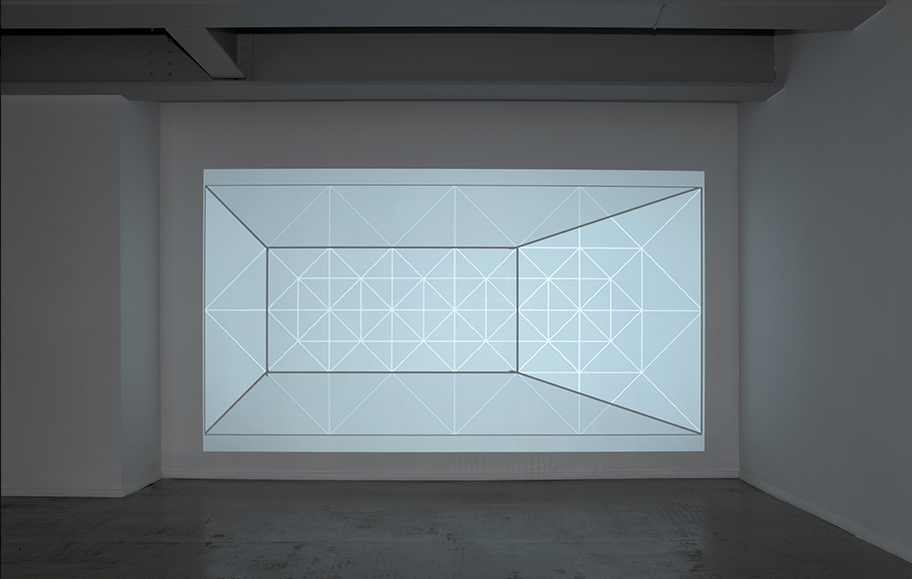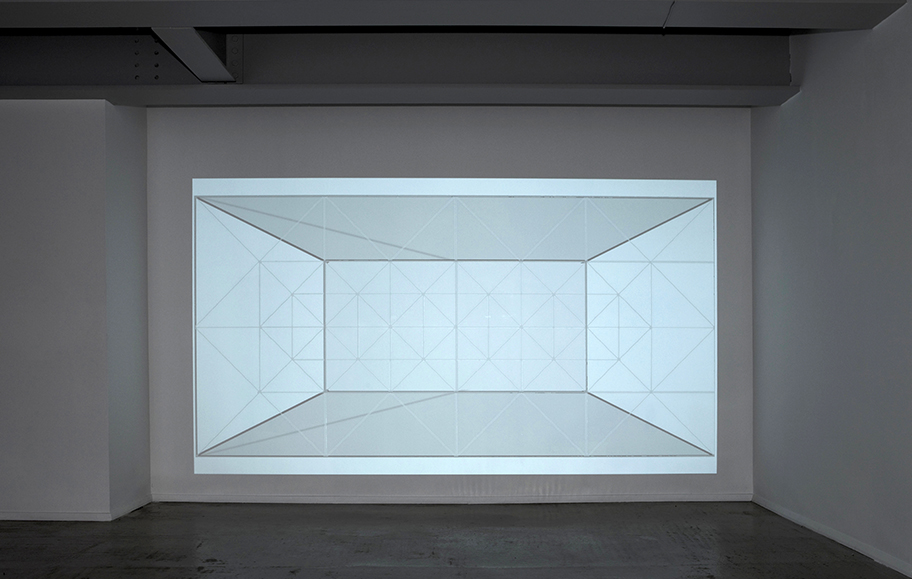Animation videos (right-click thumbnails to download)







The work in the exhibition– drawings and videos, intentionally tackles head-on both the anomalies evident in key early renaissance paintings, and the orthodoxies and assumptions around what perspective is, and what it does. The work proposes that implicit in the geometry of perspective there is an ambiguity, which is why it continues to defy any fixed analysis and interpretation; it proposes that it never was the fixed entity – the ‘rational’ system, or even the ‘culturally determined’ system that it is generally now taken to be, or is presented as.
The research uses evidence from early renaissance paintings – in particular those paintings that form the bedrock of the orthodox historical narrative, but in which it can be demonstrated that we are not looking at what we may think we are looking at.
For example, the floor in Domenico Veneziano’s ‘St Lucy Altarpiece’, which we read as a being a tiled floor containing a regular six-pointed star pattern, is a clear case of ‘all not being what it seems’ - an illusion of an illusion. On closer inspection, this pattern is produced from a simple construction of squares drawn within squares, which is then interpreted as a hexagonal pattern. This raises many questions and possibilities: the artist may have thought it was the correct way to produce a true perspective rendering of a true hexagonal pattern, or he may have been perfectly aware of the deception. It could also that he took advantage of a fortuitous accident, or even that none of these alternatives adequately describes what took place. It does, however, raise fundamental questions about artists’ intentions, the role of geometry as a ‘tool’ and as a generator of imagery. It raises clear doubts about our assumptions used by historians to

His investigation, initiated during an AHRC fellowship in Creative and Performing Arts held at Newcastle University between 2004 and 2009, is driven by two key concerns. On the one hand, Talbot is concerned with the relationship and dependency between imagery, process and drawing method; this concern has its roots in his own practice and the insights gained through making large complex drawings. On the other, the knowledge and understanding of linear perspective he has gained in this practice, in many respects, undermines the orthodox thinking, histories and other portrayals of perspective.
This has led to the question: has there has been a fundamental misunderstanding by historians, cultural commentators and artists, about the nature, purpose and consequently, the origins of perspective? Is our understanding limited, or constrained by, the apparently common-sense notion that linear perspective is a tool for depicting three-dimensions?
Linear Perspective’s position as a ‘tool’ for mapping spatial relationships on to a two-dimensional surface is very well established. Alberti’s codification of perspective sets it out clearly as a system of projection that defines the relationship between the eye, the picture plane and the external world. And despite more recent commentary regarding its broader cultural significance and veracity, what perspective is – its role and purpose for the artist – appears irrefutable. Yet the very 15C paintings that are held by historians to embody the new-found ‘rational’ knowledge of perspective also exhibit unique spatial/compositional qualities that cannot be readily accounted for. Yes – most of the elements within these paintings appear to be in correct ‘measurable’ relation to each other throughout the depth of the paintings – so much so that we can reconstruct the ‘real’ space depicted in, for instance, Piero’s Flagellation.
But it appears that along with Masaccio, Domenico Veneziano, Leonardo, Piero was also controlling how those elements that are in the depth of the painting relate to each other on the surface of the painting. Why should this be, and the awkward question for historians is, how could this be? It is not something that could be easily or readily achieved using the geometric methods described by Alberti. It would seem to indicate a visual concern or approach amongst these artists that transcends the assumed intended purpose of linear perspective - the convincing illusion of three dimensions on the picture plane. Talbot is also critical of the common ‘explanation’ of these anomalies, that ‘these artists are geniuses, and that the rules of perspective are there to be broken’.

Talbot suggests that the key to unravelling this problem lays in the fact that we habitually think of the trappings of linear perspective, particularly its geometry, solely as means to an end. We overlook the fact that flat geometric diagrams, including patterns and those diagrams used in perspective constructions, can themselves be suggestive of depth, can suggest imagery, can be inherently ambiguous, and can therefore, be visually and conceptually exciting for the artist. What we are seeing in these paintings, the anomalies and coincidences, are the traces of a creative interplay between depth and flatness.
James Elkins has written about there being multiple ‘perspectives’ in the renaissance, a whole panoply of different methods and constructions, and ones which were not necessarily seen at the time as being connected, or even having the same underlying geometric basis. This may well be the case, but Talbot’s insights relate more specifically to the nature of the geometric constructions themselves, and our assumptions about how, and why, they were used. The two key insights for Talbot are, firstly, that at the very heart of linear perspective’s geometry there is a level of ambiguity, a duality, and this creates a situation in which artists can respond to, or ‘play’ with, these potential uncertainties. The dualities are the result of diagrams being able to be read as either spatial or flat. Secondly, and as a consequence of the first, that the geometry of perspective is much more than a ‘means to an end’; it is not merely a set of mechanical geometric operations with a single defined purpose and result. This insight then throws into question the very assumptions surrounding the narrative of its origins.
Therefore building upon, and at times critical of, many of the key texts in the history of perspective, Talbot poses the theory that, as in the making of his own work, several Renaissance artists used the geometry of Linear Perspective as a remarkably flexible and subtle creative tool, constructing the space within the paintings from a flat surface matrix, rather than vice versa. Yes – the geometric basis as described by Alberti holds true, but the inherent duality enables artists to respond to more than the simple prosaic ‘task at hand’. It enables a play between surface and depth, something which artists continue to be engaged with to this day.
As a way of both testing and demonstrating this theory Talbot’s series of drawings and animations based on drawings, show the fluid and multiple spatial interpretations of relatively simple geometric constructions.

The video demonstrates, and embodies, the alternative interpretations possible within the most simple of perspective constructions. Its installation – filling a full wall of the gallery, references for example, the spatial anomalies apparent in Leonardo’s ‘Last Supper’. The drawings likewise, instead of dealing with ‘depth’, extend the space sideways thereby creating the possibility of a time-based narrative within the space of the drawing. This alternative solution references, for instance, Piero’s ‘Flagellation’, and Uccello’s ‘Profanation of the Host’.
The research raises the interesting thought that the imperatives driving the understanding of the geometry of linear perspective may be the exact reverse of that normally advanced; rather than being driven by a need or desire to know how to depict three-dimensional space on a flat plane, it was driven by an attempt to understand what three-dimensional space was represented by a particular flat geometric configuration –a pattern for instance.
Talbot’s research was presented at Platform A Gallery, Middlesbrough, and at the Globe Gallery, Newcastle upon Tyne in 2013. His work has also recently been presented in peer-reviewed fine art and art history arenas, including:
- 'Drawing Connections' – a chapter in 'Writing on Drawing' . ed. Steve Garner, Intellect Books, 2008.
- ' Perspective: what it doesn't say on the tin' – a peer-reviewed paper presented in session 'Creative practice interventions in Art History' at 'Creative Practice, Creative Research' Conference, York St John University, 2009.
- 'Perspective and Spatial Play' – a paper presented at the Renaissance Society of America session 'Reappraising the Role of Illusionism in Early Modern Painting', Venice 2010.












